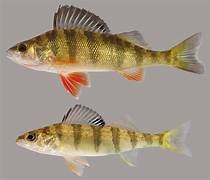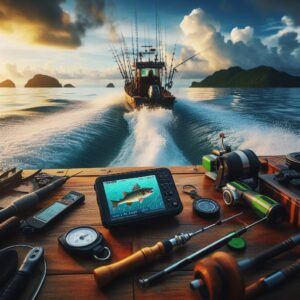Introduction to the Great Lakes: A Freshwater Fishing Paradise

The ecosystem of the Great Lakes, being the largest freshwater system in the World supports many species of sport fish and bait fish alike.
The Great Lake are among the most pristine freshwater lakes regardless of the many threats they face such as overfishing, invasive species and shipping pollution.
Invasive species include but are limited to:

- Zebra and Quagga Mussels, these mussels are filter feeding by-valves that attach themselves to structure causing blockage of water intake for municipal use, engine cooling and alter natural food web production.
- Sea Lamprey. Parasitic species of fish that feeds on the blood of native fish.
- Alewife. A plankton eating fish, that is also a food source for larger fish, eats the natural plankton causing depletion of native small bait fish.
- The Round Goby. A small bottom feeding fish that feeds the same as the native Perch causing a food and habitat shortage.
Invasive species harm the ecosystem of the Great lakes by invading and competing for food sources, attaching to structure and killing native fish.
The Great Lakes are a must-visit destination for anglers of all ages and experience levels. The vast number of native species of fish creates a never-ending variety of fishing pursuits.
The most popular species of sport fish in the Great Lakes and where to find them.

- Walleye: Lake Erie, Lake Superior, Lake Michigan. Lake Huron
- Yellow Perch: Lake Erie, Lake Michigan. Lake Huron
- White sturgeon: Lake Michigan and Lake Superior, Lake Erie
- Ruffe Perch: Lake Erie. Lake Erie, Lake Michigan
- Burbot Catfish” All Lakes
- Channel Catfish: All Lakes
- Small Mouth and Largemouth Bass: All Lakes and cool backwaters and streams
- Atlantic Salmon (non-native) Lake Ontario, Lake Michigan, Lake Superior. Lake Erie
- Steel Head Trout: Lake Erie, Lake Michigan, Lake Superior, Lake Ontario

- Chinook: Lake Michigan, Lake Superior, Lake Ontario
- Rainbow Trout: Lake Michigan, Lake Superior, Lake Erie, Huron
- Northern Pike: Lake Superior, Lake Erie. Lake Huron
- Lake Trout: Lake Erie, Lake Michigan, Lake Superior. Lake Huron, Lake Ontario
- Brown Trout: Lake Michigan, Lake Superior, Lake Ontario, Lake Erie
- Brook Tout: Lake Michigan, Lake Superior, Lake Ontario
- White Fish: Lake Superior, Lake Erie, Lake Huron
- Rainbow smelt: Lake Ontario, Lake Erie’
- The best 4 Great Lakes fish to eat: Walley, Yellow Pirch. Small -mouth Bass and Coho Salmon

Understanding the Great Lakes Ecosystem: Key to Successful Angling
The ecosystem of the Great Lakes provides for many human used recourses. The ecosystem provides:
- Hydro Power
- Fishing, both recreational and pleasure
- Municipal drinking water
- Farm irrigation
- Recreational activities
- Migration habitat
The Great Lakes are important ingredient to many local economies both in The US and Canada. Each change in season brings a new type of pursuit and with it, a new group of adventurers. All whom contribute to the local economies.
As the seasons change, the fish and other wildlife migrate to more favorable habitat and temperatures. Learning these migration habits is essential to successful fishing expedition. This is where the seasoned Charter Capitan or Guide service comes in. They track the different species of fish year around to insure successful fishing adventures. Even if you have your own boat, take a local charter, make friends with the Capitan and stay in touch. Most Capitan’s love to help people catch fish, especially those who charter him on occasion.
Weather and water temperature have a definitive effect on the success of fishing. The most important thing to understand is that cooler water holds more diluted oxygen than warm water, however, most fish are less active in cold water and require less food to survive, but in warmer water tend to be more active and need more food to survive. These two-temperature effects are what drives fish to a certain water level, water temperature and also drives the migration of the different species. Many species of fish, but Walleye in particular will move from shallow warmer waters in the spring to deeper and deeper cooler waters as summer progresses.
Another condition that moves fish is the weather. Fishing is always better in changing barometric pressure from low to high, which happens before storm events. Fishing during a storm is rarely very productive and can be quite dangerous as you are likely the highest point above the water and therefore an attractor of lightning. Barometric pressure during a storm is always high, then decreases, usually, over a 72-hour period to a new low pressure and fishing will return to normal.
Wind is another factor. Winds come from either the Southwest or South except when the jet streams dip further South and causes a North wind. The speed of wind is influenced by the surrounding barometric pressures. This causes friction across the top surface of the water causing waves. In some cases, especially for Walley, the waves can be a benefit if they don’t get too high. In other cases, the waves will likely increase the turbidity of the water, pulling currents and nutrients along with them.

Tackling the Challenge: Gear and Techniques for Great Lakes Fishing
First and foremost, you will need a rod and reel combination to fit the type of fishing you will be doing. The three most common fishing methods used on the Great Lakes are casting from shore, drifting in a boat and, the most popular, trolling.
Casting from shore will be most successful with a spinning rod and reel combo for lightweight lures and live bait or a casting rod and reel for heavier lures and bait. Medium weight gear is the best choice for the beginner and even the experienced angler. If purchasing your rod and reel as a package, they quite often come with line already on the reel, if not get a 12lb. monofilament. This combination should handle anything you may catch from shore. The hook size depends on the targeted fish.
- Panfish (sunfish, perch, etc.) Bait hook, J-hook, Aberdeen hook, Jig head …#4 to #12
- White Bass-hook, Jighead#1 to #4
- Smallmouth Bass-hook, Jig head, Worm hook3/0, 2/0, 1/0, #1-#3
- Walleye
- Modern angling techniques vs. traditional Great Lakes fishing methods
- Catch and release practices: Sustainable fishing in the Great Lakes
Navigating the Waters: Strategies for Locating Prime Fishing Spots

I’m going to reveal to you the thrills and occasional frustrations you might face in the quest for the ultimate fishing spots. This isn’t just about casting your line and hoping for the best; it’s also about the science and art behind locating those elusive hotspots where fish congregate.
You’re going to find out about how to read lake maps – a critical skill for any successful angler. I’ll show you how to interpret the subtleties of contours, understand the implications of different structures, and assess water depths so you can anticipate where your catch might be hiding.
In the upcoming section, we’re going to tackle how modern technology has revolutionized fishing. The application of sonar, the precision of GPS, and the capabilities of sophisticated fish finders all combine to take guesswork out of the equation. We will delve into that technology and how you can harness it to your advantage.
The Angler’s Ethos: Conservation Efforts and Respect for the Great Lakes

Today, I’m going to be talking about something near and dear to many of us: the Great Lakes. This isn’t just about the staggering volume of water they contain; it’s also about their incredible biodiversity. The Great Lakes ecosystem is a complex, interconnected web of life, supporting thousands of plant and animal species. Some, like the lake sturgeon, are ancient relics dating back to the time of the dinosaurs, while others, such as myriad bird species, rely on these waters as critical waypoints on their migratory paths.
If you want to understand why it’s crucial, we maintain the Great Lakes not only for our enjoyment but also for the survival of countless species, it’s important to grasp their role in the environment. These lakes act as a massive natural reservoir, influencing weather patterns and providing habitats for aquatic and terrestrial life alike. They’re a cornerstone for regional biodiversity, offering nesting grounds, food sources, and spawning habitats.
You’re going to find out about what makes the Great Lakes tick, from the smallest plankton that form the basis of the food web to the largest predators that rule the waves. It’s a delicate balance, one that’s easily tipped by pollution, invasive species, and changing climate conditions. But it’s not all doom and gloom; there are plenty of reasons to be optimistic thanks to the collective effort of conservation-minded individuals and groups.
In my opinion, anglers have a big stake in this game. They’re often the first to witness changes in the lakes’ health, be it through shifts in fish populations or the appearance of harmful algal blooms. That’s why it’s critical for anglers to be informed and engaged in the preservation of this incredible natural resource.
Don’t worry too much about the technicalities; we’ll explore the various threads that make up this environmental tapestry. The key takeaway? These magnificent lakes provide way more than just a spot for your next fishing trip. They’re a vibrant, living system—one that we’re all part of and responsible for keeping alive and thriving.
So, this brings the question, what’s being done to protect the Great Lakes and how can we, especially as anglers, get involved? That’s going to include looking at current conservation programs, proactive measures we can take, and why promoting ethical fishing matters more than ever.
Any questions or comments? Leave them below. I will be sure to respond. Thanks for visiting.
